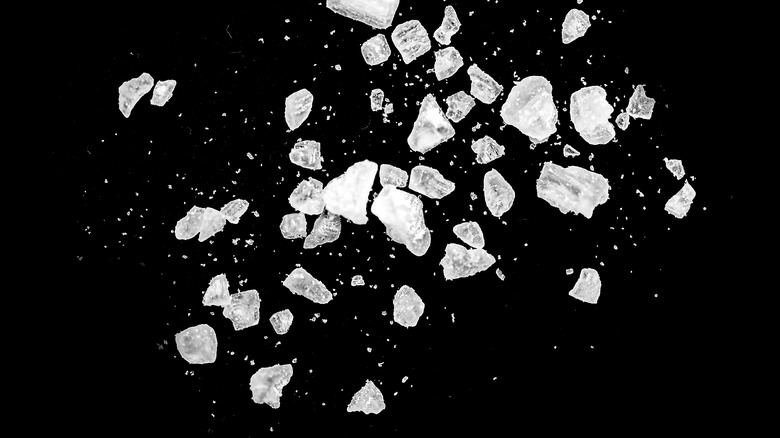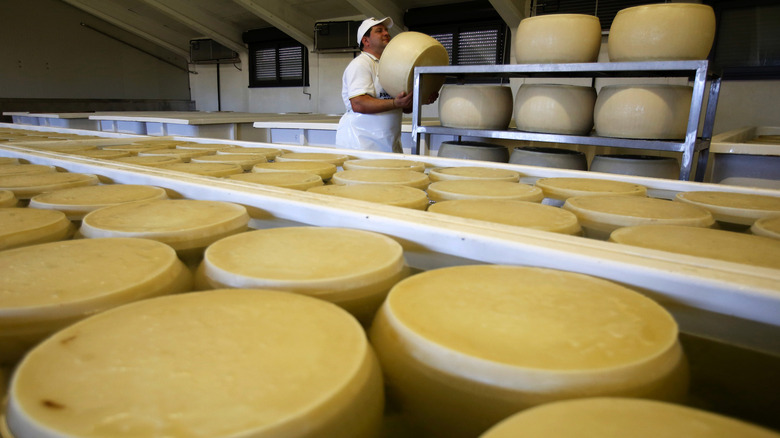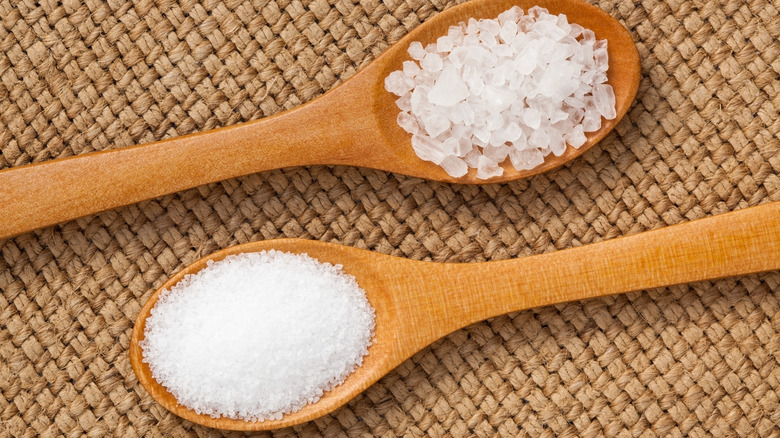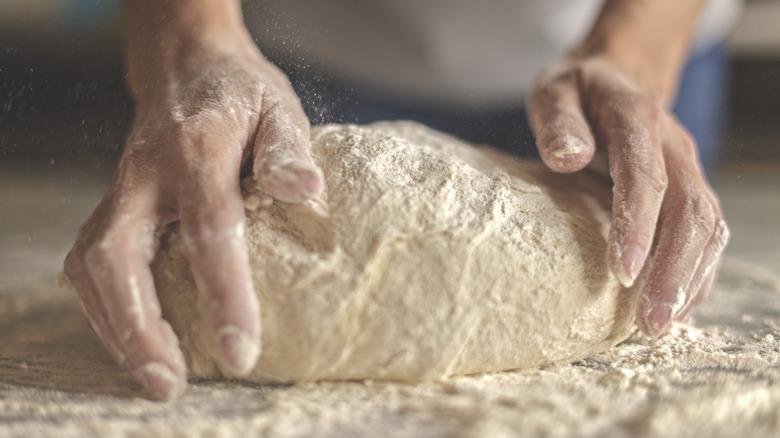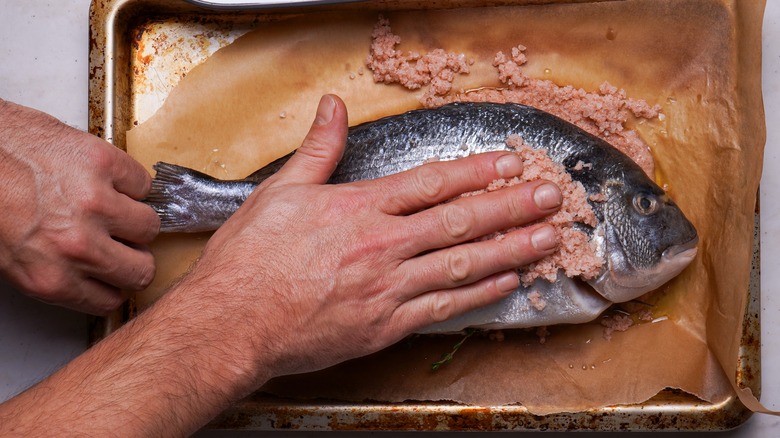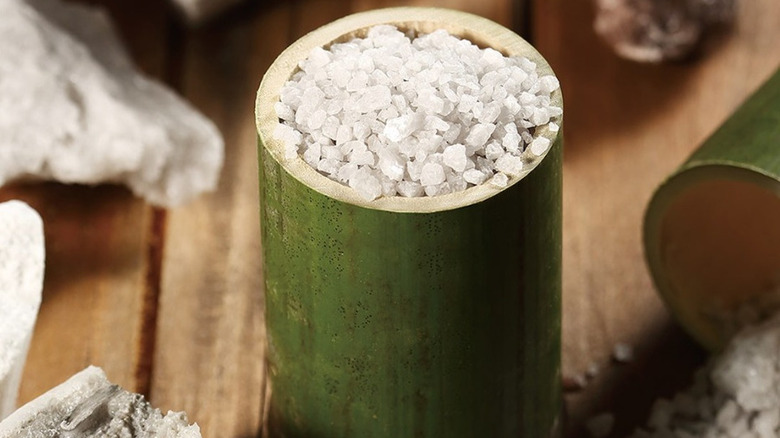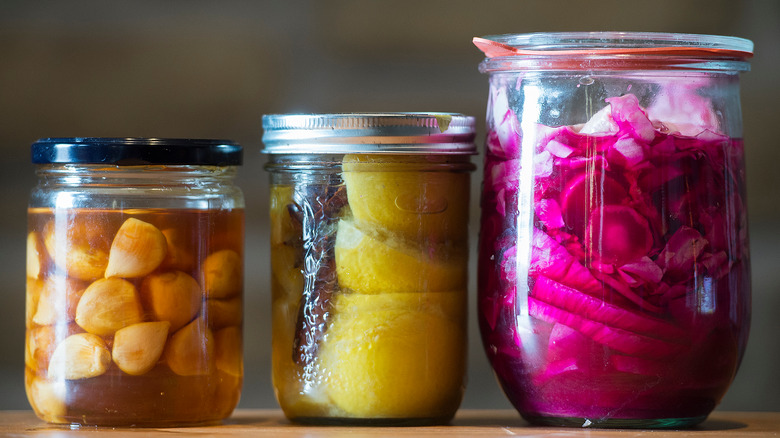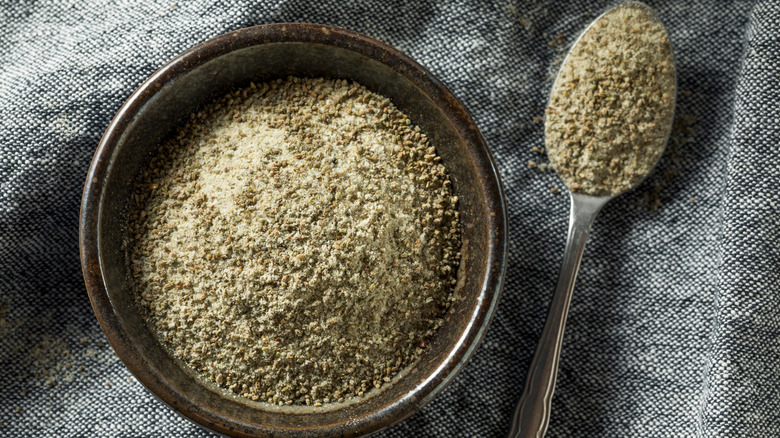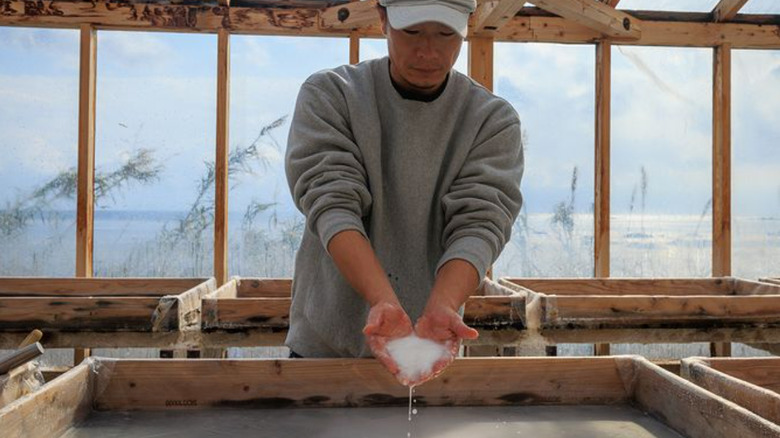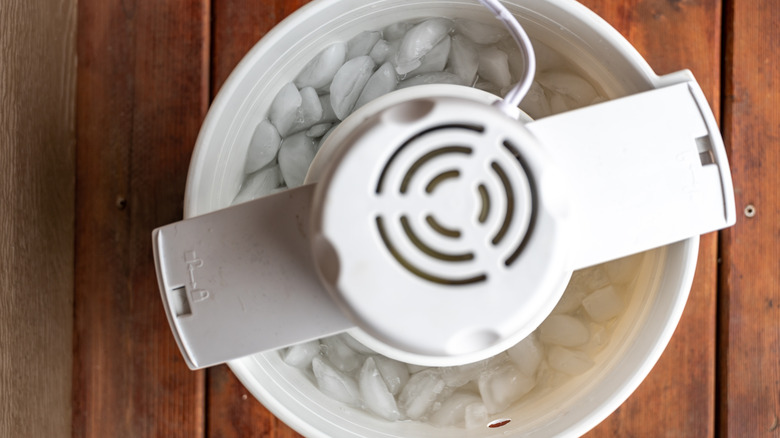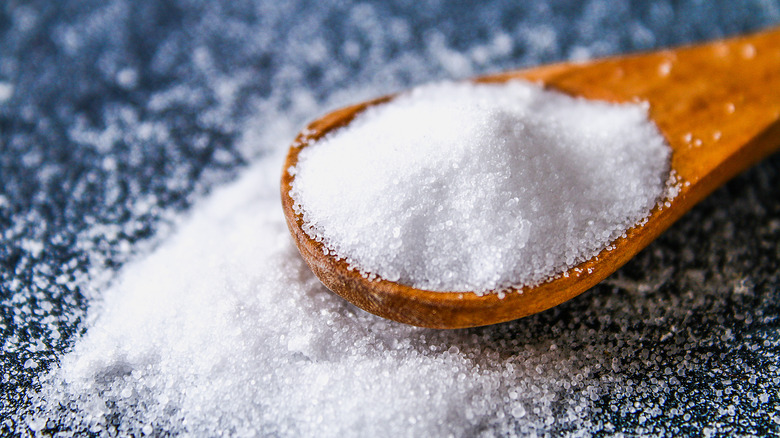12 Of The Most Interesting Salt Facts
Salt is a common mineral found everywhere, from seawater and caves, to our tears. It's so readily available that we sometimes forget how important it is to the way we cook, eat, and taste food. Every time you pick up a pinch of salt between your fingers, you hold a decisive power over the final direction, the grand finale of your meal. Move a few inches north, and it's inedible, but get it just right and you've discovered a way to connect all independent ingredients and make them dance to the same tune.
With its firm ability to put everything where it belongs, salt plays a monumental role in the science of flavor. But saying that's all there is to it would be an understatement. The deeper you dive, the more fascinating the relationship between food and salt becomes. To show that, we've put together a list of some of the most fascinating facts about salt. From why the size and shape of the salt crystal define its saltiness to how it's used to make ice cream freeze, there's plenty to learn.
1. Salt is an essential ingredient in making cheese
We often associate salt with the briny flavor in the cheese, but its role in cheesemaking goes far beyond taste. Without it, the bacteria in the cheese would run wild, converting lactose into lactic acid with boisterous enthusiasm. Salt slows down this process, providing the cheesemaker with essential control. This regulated acidity and texture development enables a broader array of distinct cheese varieties and flavors, as well as giving them longer shelf lives.
Apart from bacterial control, salt also acts as a moisture manager in the cheese. It draws water out of the curd, aiding in the drying process. This is particularly crucial for aged cheeses with their firm character. In some cheeses, in fact, salt is used to develop the cheese's rind. In the making of Brie, salt promotes the growth of molds and bacteria that create those gorgeous soft rinds. In more complex cheese varieties like Parmesan or Gouda, salt plays a different role by drying the rind to create a sturdy and robust shell. Over the past few years, the call for reduced salt content in cheese products has grown louder, as have health concerns related to its consumption. However, as attempts at finding an adequate alternative for salt remain challenging, its role continues to be an important one.
2. The size of salt crystals define how salty your salt is
Pick any salt and, at its core, you will find the familiarity of sodium chloride. So why do some salts taste more salty than others? Well, it turns out that the size and shape of salt crystals have a remarkable impact on this. As salt crystals dissolve, they release sodium ions which give the salt its familiar saltiness. Smaller crystals dissolve quickly and hit you with immediate saltiness, while larger, coarser crystals dissolve slowly and take time to release their ions.
To see this in practice, it's enough to pick up any regular sea salt and look at it closely. You'll notice it has somewhat irregular crystals. Those crystals will dissolve at different rates, providing food with subtle complexity. On the other hand, if you examine kosher salt, you'll see it has larger and more uniform crystals, which will dissolve more evenly. Thanks to its distinctive crystals, kosher salt also gives you tactile control over salting with your fingers.
Another thing to think about when choosing a suitable salt is its density, or simply put, how those tiny salt crystals stack up in a given space. This is hugely important for recipe conversions. Generally, you'll find you need much less Maldon sea salt than Diamond kosher salt to achieve the same level of saltiness in your dish.
3. Salt is a secret ingredient in baking with yeast
Yeast is a living microorganism that feeds on sugar and produces carbon dioxide and alcohol as by-products. This process is called fermentation, which gives baked goods their fluffy texture full of air pockets. However, yeast can also grow out of control and consume all the sugar in the dough, quickly turning your bread project into a sticky mess. That's where salt comes in.
When it comes to baking with yeast, salt has two main functions. First, it slows down yeast growth by dehydrating it and inhibiting its enzymes. This allows the dough to rise at a controlled rate and develop more consistent results. Second, it strengthens the gluten network in the flour, which gives the dough more elasticity and structure while also helping the dough retain the gas bubbles produced by the yeast and preventing it from collapsing. As an added bonus, salt can improve the color of the crust as well. It stops the yeast from consuming all the residual sugar, allowing the crust to properly caramelize.
Whenever you're making yeast bread, aim for 1.8-2.2% of salt per flour weight. So, if you were to use 500 grams of flour, you'd need to add 9-11 grams of salt to your mixture. You can adjust this ratio slightly to match the style of bread you're making.
4. You can cook foods in a salt crust
Salt crust baking is an age-old technique used across many world cuisines to this day. If you travel along the Mediterranean coast of Spain, you will find salt-crusted fish or pescado a la sal, usually sea bass or bream baked in salt, while Southern China is renowned for its specialty, Hakka salt-baked chicken.
The salt-crust method is a fantastic way to keep your cooked dish tender. By trapping the moisture inside the crust, this simple yet highly effective technique ensures that your food retains all of its precious juices. The salt crust has excellent insulating properties (and poor heat conductivity), so your dish will cook slowly and gently, safe from any heat damage.
Salt baking works wonders for various foods, from meats and fish to root vegetables like turnips and parsnips — a succulent side dish for your roast dinner. To make a salt crust, you need a lot of salt (it is best to use coarse sea salt or kosher salt) and a binder, such as water or egg whites. Simply mix the salt and the binder to form a paste and pack around the food, leaving no gaps or holes. Bake the crust in a hot oven until it hardens and turns golden, and enjoy extra juicy results.
5. Salt can trigger cravings and addiction
When life's pressures mount, we often turn to comfort foods for solace. It's a well-known phenomenon: Stress often leads to cravings, not just for any food, but those high in fat, sugar, and salt. The longing for salty foods, according to Healthline, can be triggered by stress but also sometimes by medical conditions like Addison's disease.
One of the main reasons we consume excessive amounts of salt is the reward system in our brains, causing the release of dopamine — a neurotransmitter responsible for inducing feelings of pleasure. Dopamine is also linked to addiction, as it drives us to seek out and repeat enjoyable activities. A study published in the Journal of Proceedings of the National Academy of Sciences in 2011 confirmed that substances causing addictive behavior trigger the same exact brain networks responsible for salt cravings.
It isn't easy, but training our taste buds to enjoy less salt can, in fact, help reduce salt cravings, according to Harvard Health. The best way to make sure you're on the right track with sodium intake is to read nutrition labels carefully and avoid processed foods.
6. Salt plays a more significant role in desserts than you think
You've probably seen a teaspoon of salt added to a cake rather often, but it deserves more credit than its weight in recipes. When used correctly, it has the power to unlock the full potential of your sweet creations, taking them way beyond the familiar flavor of salted caramel. By offsetting sugar with salt, you will ensure your desserts are not overwhelmingly sweet. Salt can also enhance the aromas of fragrant spices such as cinnamon and nutmeg in a spiced honey cake, or make the citrus flavor in a lemon tart more vigorous and lively.
With just a pinch of salt, you can enhance the flavor of your chocolate truffle mix, cake batter, or ganache. For an extra touch, sprinkle some flaky salt on your chocolate chip cookies and fudge. Salt also complements the natural sweetness and acidity of fruit, so try adding it to your fruit pies and crumbles.
When a recipe calls for salt, sea salt is the most neutral choice. It has a pure and clean flavor profile, which makes it ideal for desserts. If you're baking, kosher salt is another excellent option, but it works best in recipes with a significant liquid part. Alternatively, you can use Moldon kosher salt as a finishing touch to your desserts.
7. South Korea makes the world's most valued salt
Korean bamboo salt is a remarkable example of how meticulous craftsmanship can turn a simple ingredient into a complex and valuable product. This precious condiment, also known as purple bamboo salt, combines sea salt with bamboo in a centuries-old tradition. The ordinary sea salt is packed into bamboo trunks and baked eight times for 12-14 hours at temperatures over 1,470 degrees Fahrenheit. This process results in a dense salt column that requires expert hands to create, as one mistake can ruin an entire month's work. The final roast, taking place at a temperature exceeding 1,800 degrees Fahrenheit, is the pinnacle of its transformation.
Once cooled, the bamboo salt takes on a coveted dark, rocky structure that requires a delicate touch to break down. The bamboo salt has a distinct salty flavor with an egg-yolk-like richness, further enriched by the nuances of bamboo oils seeping into the salt during roasting. The price for this exclusive nine-times-roasted salt can reach anywhere between $179 to $224 per kilogram, reflecting the laborious work that goes into making it.
Despite the hefty price tag, bamboo salt is a popular seasoning in Korea, often added to soups, rice, and kimchi. It can also be used as a finishing salt, perfect for sprinkling on salads, grilled meats, or seafood. Despite some studies suggesting that bamboo salt has higher levels of essential minerals like iron, potassium, and calcium than regular sea salt, on the chemical level, it's still sodium chloride underneath.
8. Salt is crucial for lacto-fermentation
Lacto-fermentation, as the name suggests, hinges on the magic of lactobacillus, a type of beneficial bacteria naturally present on the skins of vegetables. When you chop vegetables and sprinkle salt, it draws out the natural juices and creates a brine. This brine covers the vegetables and protects them from the harmful effects of oxygen. At the same time, the salt acts as a guard, keeping harmful bacteria away and allowing fermentation to occur.
Some vegetables are drier, while others ooze with natural juices. The preservation method, therefore, will vary between brining and dry salting. For vegetables with lower water content, such as carrots or chilies, brining ensures they stay submerged during fermentation. On the other hand, finely chopped or water-rich vegetables like cabbages thrive with dry salting, as the salt draws out their natural juices. The amount of salt should typically be between 2 to 5% of the total weight of vegetables. Too little salt invites pathogenic bacteria, while too much might impede fermentation.
Whether you're making sauerkraut or kimchi, what salt to use is purely down to your preference. You may find many claims against using iodized salt for fermentation, but a study published in the Journal of Food Microbiology in 2018 confirmed that iodine has minimal effect on fermentation activities. So, any salt will work as long as you follow weight ratio guidelines.
9. You can make your own salt from celery seeds
Celery is known for its mineral-rich flavor, but did you know that dried celery and celery seeds make for an excellent salt alternative? The classic way calls for mixing one part of celery seeds with two parts of salt and grinding them together in a spice grinder, mortar, or food processor, but you can do it using only celery seeds mixed with dried celery flakes. This will produce a fine, less intense salt, perfect if you're watching your sodium intake.
A great thing about celery salt is that it has several health benefits that regular salt doesn't. Notably, celery seeds contain compounds like flavonoids, coumarins, and linoleic acid, which have anti-inflammatory and antioxidant properties per the Journal of Evidence-Based Complementary Alternative Medicine and the ability to lower blood pressure per Cleveland Clinic. According to Healthline, celery seeds may also promote bone health and blood sugar regulation.
With celery salt, you can elevate your snack game by sprinkling it over popcorn or fries or infuse your morning routine with celery salt-flavored scrambled eggs. For a creamy and tangy twist, blend celery salt with mayonnaise, sour cream, or yogurt to make a luscious dressing for salads and sandwiches. Remember, when using celery salt without additional salt, you'll need plenty of it to achieve the same saltiness levels as regular salt.
10. There are over 4,000 salt varieties in Japan
Salt to Japanese is what the tomato is to Italians. With over 4,000 unique salt varieties, the country's salt scene goes far beyond your typical table salt. To experience the full diversity of Japanese salts, it's enough to visit Ma-suya, one of the most well-known salt shops in Japan (and the world). This store is not your average supermarket. It's a haven for salt enthusiasts, showcasing 300 different types of salt, each with its own distinctive flavor and purpose. At Ma-suya, you will be greeted by knowledgeable salt sommeliers keen to assist you, which is necessary given the variety of salt at the shop.
All salts produced in Japan are harvested from the sea, but not all are sea salt. One such distinguished salt variety is moshio, which Japanese salt masters make by boiling dried hondawara seaweed in water and then evaporating the remaining brine to get the salt crystals. Moshio has a pale, toasted beige color and a deep, rich flavor with enough complexity to elevate simple ingredients like rice or fish.
The obsession with salt in Japan extends into popular salt blends like matcha-shio (salt blended with green tea powder) or yuzu-shio (salt mixed with Japanese citrus), but nothing beats furikake, a salty Japanese household sprinkle. Variations of this savory condiment are endless, but the most popular ingredients you'll see used to make it are dried seaweed like kombu or nori, salted bonito flakes (dried flaky tuna), and toasted sesame seeds.
11. Rock salt helps to freeze ice cream
Salt plays a crucial role in the ice cream-making process, but it has nothing to do with the flavor of the ice cream. Instead, salt is used in ice cream machines to regulate the water freezing temperature. Simply, ice cream freezes (and melts) at a lower temperature than water because sugar and fats in the mix hinder ice crystal formation. That's where the salt steps in.
Water freezes at 32 degrees Fahrenheit, but when you add salt, the freezing point drops. This drop is called freezing-point depression, and it's the secret behind the ice-cold and creamy texture of the ice cream. In fact, you can replicate this experiment at home without a fancy ice cream machine. Grab two bags, one small, one large. Fill the small one with your ice cream mixture, seal it, and place it in the larger bag filled with ice and rock salt. Shake vigorously for about 15 minutes, and there you have it — you've just made yourself a simple homemade ice cream.
12. There's more than one way we taste salt
Contrary to what you might believe, saltiness is not a one-size-fits-all experience. Rather, there are two distinct ways we perceive saltiness. The first one lets us know when there's just the right amount of salt in our food — usually geared toward the lower end. Meanwhile, the second comes into play when salt levels are dangerously high, guarding us from ingesting too much sodium.
The ability of our taste buds to perceive saltiness on multiple levels is not a mere quirk; it serves an essential purpose. Our bodies require sodium for muscle and nerve function, but an excess can be harmful. Therefore, this natural ability to detect saltiness on different planes helps us maintain balance, as described by Stephen Roper, a neuroscientist at the University of Miami Miller School of Medicine in Florida. He calls it "the Goldilocks principle," where we aim for the perfect amount of sodium, not too much or too little (via Knowable Magazine).
Interestingly, while we have a good knowledge base on the low-salt receptor, the high-salt receptor and the taste bud cells that host these receptors remain less understood and are among the most significant gaps in our knowledge of taste.
